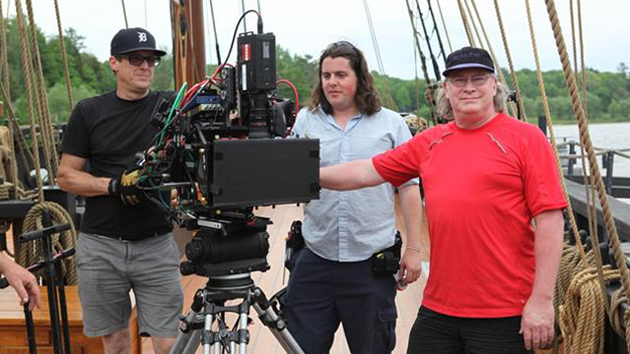This Dual SDI-to-HDMI Mini Converter Lets Us Bring Large, Flat-Panels Displays into the Mix on Set
We have been doing 3D for about four years now here at DJ Woods, and still we find that during production we need different options for handling different alignment issues. Until recently, when we worked on set and needed to test or tweak aspects of our 3D rig, we were limited to using the very small 8-inch displays on our monitoring units. This setup made it difficult for us to see where we needed to make adjustments. However, that all changed with the recent addition of a Matrox MC-100 dual SDI-to-HDMI mini converter to our field kit.
Now, we are able to bring 46-inch flat panel monitors on location and use them to put up test patterns to check alignment, color, and other critical elements of our 3D shoot. As a result, we can see alignment issues more clearly and can align our rig ever more precisely. Before adopting the MC-100, we had to bring a much more costly and much less portable 19-inch rack-mount box to the set in order to gain the same capability.
Because the Matrox MC-100 is a small and versatile unit that can be moved anywhere with ease — and connected and attached in all variety of ways — it gives us more of the on-set functionality we need when shooting 3D than I could find with any other device on the market. Bigger is better, when it comes to monitoring and adjusting our 3D camera rig, so once I discovered that we could use the MC-100 to convert our SDI outputs for monitoring on affordable HDMI displays, I made the box a regular part of our kit.
We typically use the MC-100 to support monitoring and assessment of side-by-side feeds on our 46-inch monitors. For 3D rig adjustment in the field, I most often use difference matte for alignment, as well as anaglyph for monitoring of 3D offsets. We use different analysis modes — also including real 3D and 50/50 — depending on the circumstances, but in all cases the ability to monitor using large-screen displays is an enormous improvement.
Because the MC-100’s dual SDI inputs and outputs allow me to address any port with any function, I use the box not only as an HD-SDI switcher, but also as a distribution amplifier and as a multiplexer. As an amplifier, the MC-100 allows us to pass through or amplify the signal while maintaining full quality. As a multiplexer, the unit can combine two HD-SDI camera feeds into one 3G-SDI transport stream for delivery over a single cable.
The ability to multiplex two SDI signals lets us cut by half the wiring required to distribute HD-SDI video signals. We do a lot of on-set digital video assists, in which we manage feeds from HD cameras to computer stations where video is recorded, edited, and enhanced with effects and fed to directors and others on set. In this application, the MC-100 has proved especially valuable for big 3D shows because it helps us to cut down on the cabling maze typically required.
The MC-100 is a powerful tool for improving on-set monitoring capabilities while simplifying cabling and signal distribution. We like this affordable solution so well that we’ve not only added the unit to our own 3D production toolkit, but also made it a part of the production packages we supply to our customers.
David Woods is the founder of DJ Woods Productions. Based in Ontario, Canada, the facility provides equipment rentals and production services for feature films, documentaries, commercials and corporate videos. Visit the website at http://djwoods.com.
[Photo, top: David Woods (far right) on set with a 3D rig that includes a Matrox MC-100]
Did you enjoy this article? Sign up to receive the StudioDaily Fix eletter containing the latest stories, including news, videos, interviews, reviews and more.










I hope Matrox first finalized this product and make it working properly before they launch it, and sell it as ‘working’. Like they did with the MXO2. It took them years to come up with firmware updates that solved some major issues, with a low service level. And yes, I was one of their buyers.
If you buy a Matrox product, my advice is test test test first with your own gear.